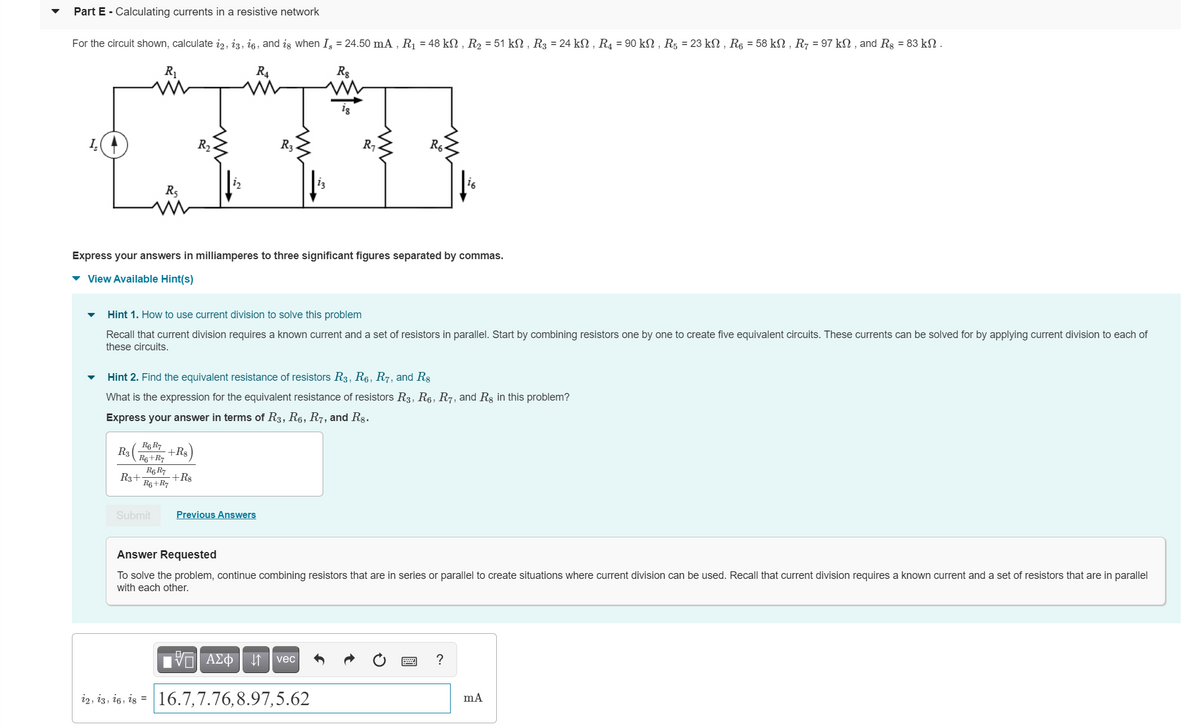Part E - Calculating currents in a resistive network For the circuit shown, calculate iz, i, ig, and is when I, = 24.50 mA , R, = 48 kN , R2 = 51 kN , R3 = 24 kN, R, = 90 kN , R, = 23 kN , R, = 58 kN, R7 = 97 kN , and Rg = 83 kN. R. Rs R Express your answers in milliamperes to three significant figures separated by commas. • View Available Hint(s) Hint 1. How to use current division to solve this problem Recall that current division requires a known current and a set of resistors in parallel. Start by combining resistors one by one to create five equivalent circuits. These currents can be solved for by applying current division to each of these circuits. Hint 2. Find the equivalent resistance of resistors R3, R6, R7, and Rs What is the expression for the equivalent resistance of resistors R3, Rg, R7, and Rs in this problem? Express your answer terms of R3, R6, R7, and Rg. R3( +R +R$ Submit Previous Answers Answer Requested To solve the problem, continue combining resistors that are in series with each other. parallel to create situations where current division can be used. Recall that current division requires a known current and a set resistors that are in parallel Vo AE ! vec ? i2, is, i6, is = 16.7,7.76,8.97,5.62 mA
Part E - Calculating currents in a resistive network For the circuit shown, calculate iz, i, ig, and is when I, = 24.50 mA , R, = 48 kN , R2 = 51 kN , R3 = 24 kN, R, = 90 kN , R, = 23 kN , R, = 58 kN, R7 = 97 kN , and Rg = 83 kN. R. Rs R Express your answers in milliamperes to three significant figures separated by commas. • View Available Hint(s) Hint 1. How to use current division to solve this problem Recall that current division requires a known current and a set of resistors in parallel. Start by combining resistors one by one to create five equivalent circuits. These currents can be solved for by applying current division to each of these circuits. Hint 2. Find the equivalent resistance of resistors R3, R6, R7, and Rs What is the expression for the equivalent resistance of resistors R3, Rg, R7, and Rs in this problem? Express your answer terms of R3, R6, R7, and Rg. R3( +R +R$ Submit Previous Answers Answer Requested To solve the problem, continue combining resistors that are in series with each other. parallel to create situations where current division can be used. Recall that current division requires a known current and a set resistors that are in parallel Vo AE ! vec ? i2, is, i6, is = 16.7,7.76,8.97,5.62 mA
Introductory Circuit Analysis (13th Edition)
13th Edition
ISBN:9780133923605
Author:Robert L. Boylestad
Publisher:Robert L. Boylestad
Chapter1: Introduction
Section: Chapter Questions
Problem 1P: Visit your local library (at school or home) and describe the extent to which it provides literature...
Related questions
Question
I need help.

Transcribed Image Text:Part E - Calculating currents in a resistive network
For the circuit shown, calculate i2, i3, i6, and ig when I, = 24.50 mA , R1 = 48 kN , R2 = 51 kN , R3 = 24 kN , R4 = 90 kN , R; = 23 kN , R6 = 58 kN , R7 = 97 kN , and Rg = 83 kN .
R1
R4
Rg
R2-
R3.
R7.
R6.
13
R5
Express your answers in milliamperes to three significant figures separated by commas.
v View Available Hint(s)
Hint 1. How to use current division to solve this problem
Recall that current division requires a known current and a set of resistors in parallel. Start by combining resistors one by one to create five equivalent circuits. These currents can be solved for by applying current division to each of
these circuits.
Hint 2. Find the equivalent resistance of resistors R3, R6, R7, and R8
What is the expression for the equivalent resistance of resistors R3, R6, R7, and Rg in this problem?
Express your answer in terms of R3, R6, R7, and Rg.
R6 R7
R3
+Rg
Rg +R7
Rg R7
+R8
R6 +R7
R3+
Submit
Previous Answers
Answer Requested
To solve the problem, continue combining resistors that are in series or parallel to create situations where current division can be used. Recall that current division requires a known current and a set of resistors that are in parallel
with each other.
vec
?
iz, is, io, is = 16.7,7.76,8.97,5.62
mA
Expert Solution
This question has been solved!
Explore an expertly crafted, step-by-step solution for a thorough understanding of key concepts.
This is a popular solution!
Trending now
This is a popular solution!
Step by step
Solved in 2 steps with 1 images

Knowledge Booster
Learn more about
Need a deep-dive on the concept behind this application? Look no further. Learn more about this topic, electrical-engineering and related others by exploring similar questions and additional content below.Recommended textbooks for you

Introductory Circuit Analysis (13th Edition)
Electrical Engineering
ISBN:
9780133923605
Author:
Robert L. Boylestad
Publisher:
PEARSON

Delmar's Standard Textbook Of Electricity
Electrical Engineering
ISBN:
9781337900348
Author:
Stephen L. Herman
Publisher:
Cengage Learning

Programmable Logic Controllers
Electrical Engineering
ISBN:
9780073373843
Author:
Frank D. Petruzella
Publisher:
McGraw-Hill Education

Introductory Circuit Analysis (13th Edition)
Electrical Engineering
ISBN:
9780133923605
Author:
Robert L. Boylestad
Publisher:
PEARSON

Delmar's Standard Textbook Of Electricity
Electrical Engineering
ISBN:
9781337900348
Author:
Stephen L. Herman
Publisher:
Cengage Learning

Programmable Logic Controllers
Electrical Engineering
ISBN:
9780073373843
Author:
Frank D. Petruzella
Publisher:
McGraw-Hill Education

Fundamentals of Electric Circuits
Electrical Engineering
ISBN:
9780078028229
Author:
Charles K Alexander, Matthew Sadiku
Publisher:
McGraw-Hill Education

Electric Circuits. (11th Edition)
Electrical Engineering
ISBN:
9780134746968
Author:
James W. Nilsson, Susan Riedel
Publisher:
PEARSON

Engineering Electromagnetics
Electrical Engineering
ISBN:
9780078028151
Author:
Hayt, William H. (william Hart), Jr, BUCK, John A.
Publisher:
Mcgraw-hill Education,